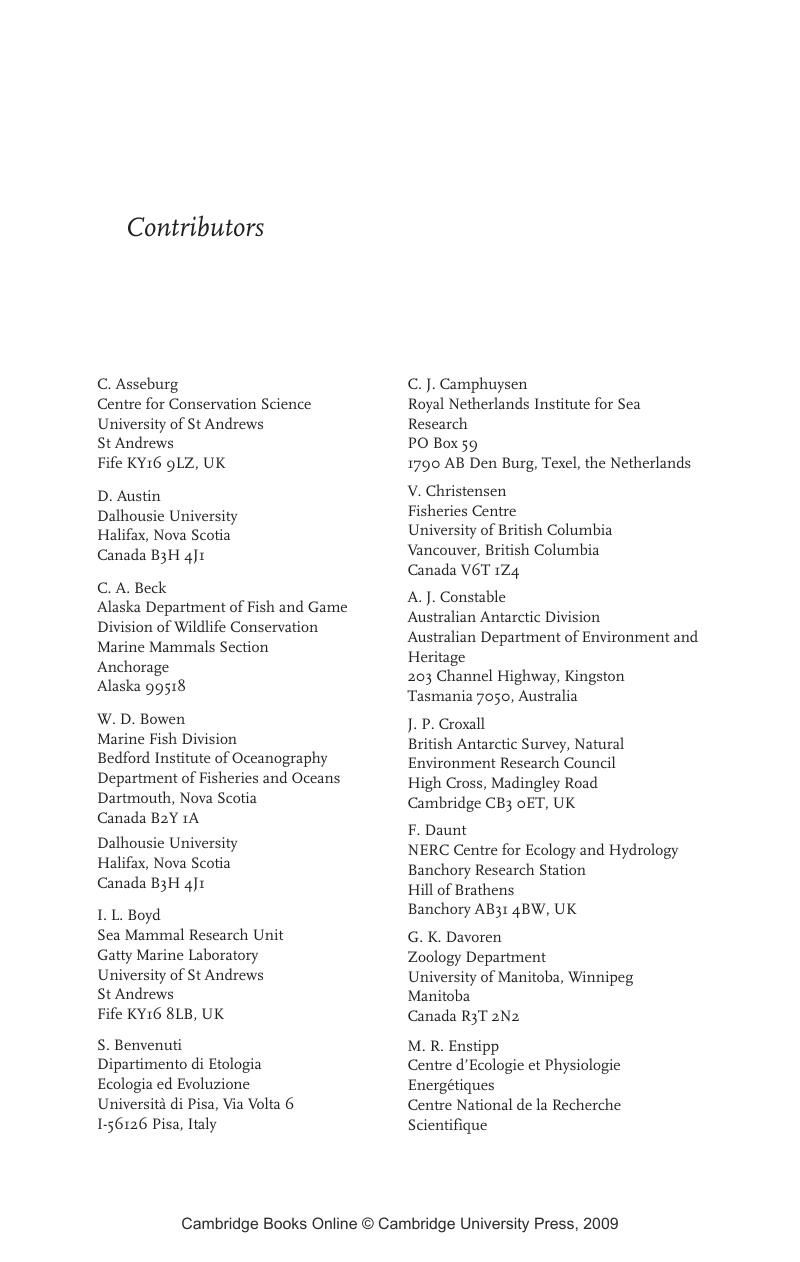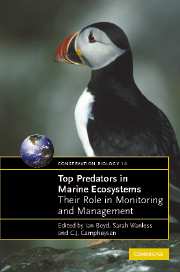Book contents
- Frontmatter
- Contents
- List of contributors
- Preface
- 1 Introduction
- 2 Effects of fisheries on ecosystems: just another top predator?
- 3 Physical forcing in the southwest Atlantic: ecosystem control
- 4 The use of biologically meaningful oceanographic indices to separate the effects of climate and fisheries on seabird breeding success
- 5 Linking predator foraging behaviour and diet with variability in continental shelf ecosystems: grey seals of eastern Canada
- 6 Distribution and foraging interactions of seabirds and marine mammals in the North Sea: multispecies foraging assemblages and habitat-specific feeding strategies
- 7 Spatial and temporal variation in the diets of polar bears across the Canadian Arctic: indicators of changes in prey populations and environment
- 8 Biophysical influences on seabird trophic assessments
- 9 Consequences of prey distribution for the foraging behaviour of top predators
- 10 Identifying drivers of change: did fisheries play a role in the spread of North Atlantic fulmars?
- 11 Monitoring predator–prey interactions using multiple predator species: the South Georgia experience
- 12 Impacts of oceanography on the foraging dynamics of seabirds in the North Sea
- 13 Foraging energetics of North Sea birds confronted with fluctuating prey availability
- 14 How many fish should we leave in the sea for seabirds and marine mammals?
- 15 Does the prohibition of industrial fishing for sandeels have any impact on local gadoid populations?
- 16 Use of gannets to monitor prey availability in the northeast Atlantic Ocean: colony size, diet and foraging behaviour
- 17 Population dynamics of Antarctic krill Euphausia superba at South Georgia: sampling with predators provides new insights
- 18 The functional response of generalist predators and its implications for the monitoring of marine ecosystems
- 19 The method of multiple hypotheses and the decline of Steller sea lions in western Alaska
- 20 Modelling the behaviour of individuals and groups of animals foraging in heterogeneous environments
- 21 The Scenario Barents Sea study: a case of minimal realistic modelling to compare management strategies for marine ecosystems
- 22 Setting management goals using information from predators
- 23 Marine reserves and higher predators
- 24 Marine management: can objectives be set for marine top predators?
- Index
List of contributors
Published online by Cambridge University Press: 31 July 2009
- Frontmatter
- Contents
- List of contributors
- Preface
- 1 Introduction
- 2 Effects of fisheries on ecosystems: just another top predator?
- 3 Physical forcing in the southwest Atlantic: ecosystem control
- 4 The use of biologically meaningful oceanographic indices to separate the effects of climate and fisheries on seabird breeding success
- 5 Linking predator foraging behaviour and diet with variability in continental shelf ecosystems: grey seals of eastern Canada
- 6 Distribution and foraging interactions of seabirds and marine mammals in the North Sea: multispecies foraging assemblages and habitat-specific feeding strategies
- 7 Spatial and temporal variation in the diets of polar bears across the Canadian Arctic: indicators of changes in prey populations and environment
- 8 Biophysical influences on seabird trophic assessments
- 9 Consequences of prey distribution for the foraging behaviour of top predators
- 10 Identifying drivers of change: did fisheries play a role in the spread of North Atlantic fulmars?
- 11 Monitoring predator–prey interactions using multiple predator species: the South Georgia experience
- 12 Impacts of oceanography on the foraging dynamics of seabirds in the North Sea
- 13 Foraging energetics of North Sea birds confronted with fluctuating prey availability
- 14 How many fish should we leave in the sea for seabirds and marine mammals?
- 15 Does the prohibition of industrial fishing for sandeels have any impact on local gadoid populations?
- 16 Use of gannets to monitor prey availability in the northeast Atlantic Ocean: colony size, diet and foraging behaviour
- 17 Population dynamics of Antarctic krill Euphausia superba at South Georgia: sampling with predators provides new insights
- 18 The functional response of generalist predators and its implications for the monitoring of marine ecosystems
- 19 The method of multiple hypotheses and the decline of Steller sea lions in western Alaska
- 20 Modelling the behaviour of individuals and groups of animals foraging in heterogeneous environments
- 21 The Scenario Barents Sea study: a case of minimal realistic modelling to compare management strategies for marine ecosystems
- 22 Setting management goals using information from predators
- 23 Marine reserves and higher predators
- 24 Marine management: can objectives be set for marine top predators?
- Index
Summary

- Type
- Chapter
- Information
- Top Predators in Marine EcosystemsTheir Role in Monitoring and Management, pp. viii - xiiPublisher: Cambridge University PressPrint publication year: 2006

